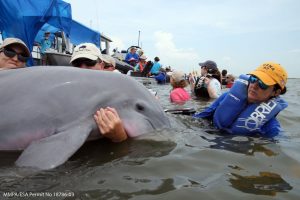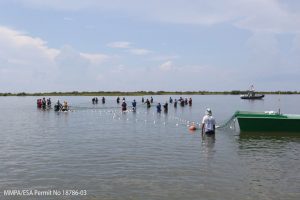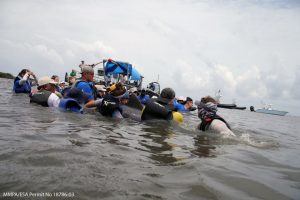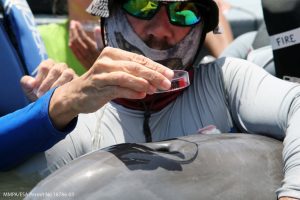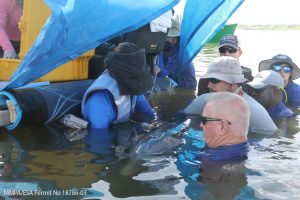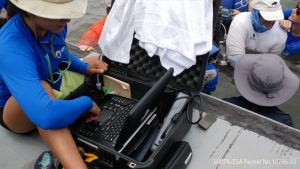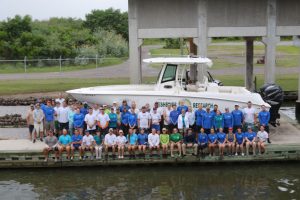Scientists Continue Monitoring Dolphins’ Health After Deepwater Horizon
– JANUARY 31, 2019
A dedicated research team of over 50 specialists from academia, non-profit organizations, animal care providers, and the National Oceanic and Atmospheric Administration (NOAA) are continuing the assessment of Gulf of Mexico dolphins to learn how the 2010 oil spill affected these vulnerable marine mammals. This year, the team completed follow-up health assessments of wild dolphins at three field sites: Grand Isle, Louisiana; Dauphin Island, Alabama; and Sarasota Bay, Florida.
The scientists are collaborating on research being conducted by the Consortium for Advanced Research on Marine Mammal Health Assessment (CARMMHA), led by Drs. Lori Schwacke and Cynthia Smith and co-Principal Investigators Drs. Randy Wells, Teri Rowles, and Brian Balmer. The cross-disciplinary team of marine mammal field biologists, ecologists, veterinarians, epidemiologists, pathologists, immunologists, cardiologists, and other specialists are using the knowledge they acquire to build models that can predict marine mammals’ recovery and stock/population-level changes.
Some Background
Following the Deepwater Horizon blowout, researchers supporting the Natural Resource Damage Assessment (NRDA) studied live and stranded dolphins in the heavily-oiled area of Louisiana’s Barataria Bay. They reported that exposed dolphins exhibited increased lung disease, adrenal gland abnormalities, late-term pregnancy losses, and an 80% reproductive failure rate – four times greater than dolphins from unaffected areas.
CARMMHA is addressing questions that have emerged since the NRDA-associated research regarding the oil spill’s overall physiological impacts on cetaceans. For example: Did exposure to oil-associated chemicals lead to heart injury? How did the oil spill affect immune mechanisms and pathways in dolphins? Did changes in prey composition and quality contribute to effects on dolphin health and recovery during and following the oil spill?
Dr. Lori Schwacke points out the unique nature of the consortium’s research:
It’s a rare opportunity to be able to pull together leading biological, veterinary, and ecological experts to work together over several years, focusing on a specific research problem. Our previous work shows that with this focused approach, scientists can answer interesting and important questions about how human activities can affect marine mammal populations. CARMMHA continues this deep dive into the specific mechanisms by which oil is having long-lasting effects on marine mammals in the Gulf of Mexico and how this will affect their populations over time.
The team will synthesize the information they gather with data from earlier NRDA studies and a parallel GoMRI-funded project, An Investigation of Mechanisms for Reproductive Failure in the Aftermath of the Deepwater Horizon Oil Spill to Understand Population Recovery Scenarios for Cetaceans. Analysis of their combined data will help researchers develop models that estimate the current condition and future recovery timelines for affected populations.
How They Study Dolphins
Getting a free-swimming dolphin into the hands of scientists to perform a health exam is no small feat!
CARMMHA strives to minimize the impact of their studies by carefully selecting the dolphins that they sample. For example, the team avoids calves that are less than two years old. After identifying one to four appropriate dolphin candidates, the assessment team waits until the target dolphins are near a shallow water area with good footing so that they can work safely. The target dolphins are encircled with a 400-yard long net (similar to a gill net used for fishing) and then safely restrained by experienced dolphin handlers.
It can take up to 10 trained handlers to safely hold a dolphin and keep it comfortable while veterinarians (two-four per animal) conduct check-ups. The veterinarians monitor how the dolphin is breathing, which tells them if the animal is calm or stressed and helps them determine the best way to care for the dolphin during the assessment. If problems arise, they will release the dolphin, though the majority are calm and cooperative after the initial surprise of capture.
The veterinarians use a stethoscope to detect heart murmurs or other audible abnormalities (auscultation) and a sonogram to visually measure the heart and see how well it moves blood from one chamber to the next (echocardiography). Ultrasound scans check for and assess the health of fetuses in pregnant females and other organs, such as the lungs. The dolphins even receive a dental check-up!
Measurements of weight, length, and girth give information about the dolphin’s body condition. Exhaled carbon dioxide levels measured at the blowhole indicate the dolphin’s respiratory health. Samples of blood, tissues, and urine add to the overall health picture. For example, stable isotopes measured in skin samples will help identify what the dolphins have been eating, and mucus collected around the blowhole might indicate if the dolphin is sick.
The team is also using satellite tags to collect data on dolphins’ movement patterns. These tags are aero-and hydro-dynamic and sit just behind the dorsal fin to minimize drag. Several CARMMHA team members have been studying dolphins in the northern Gulf for many years using photographic-identification of individual dolphins’ dorsal fins. They have made matches from field sites in Mississippi and the Florida Panhandle, which suggest that coastal dolphins have ranges of over 300 km.
These coastal stock dolphins are less well studied than the dolphins that stay within specific bays, sounds, and estuaries, and the CARMMHA team wants to learn more about them (and whether/how the oil spill affected them). The efforts near Dauphin Island were specifically designed to sample the coastal stock dolphins. Hopefully, data from the satellite tags and genetic analyses will confirm that the dolphins they sampled are indeed part of the northern Gulf of Mexico Coastal Stock.
Assessments This Year
- Sarasota Bay, Florida. In June, the team conducted health assessments on 20 dolphins (10 females, 10 males from 2-48 years old) in Sarasota Bay, which was not directly affected by the oil spill. Of the younger animals, six had never been captured before, and they were accompanied by mothers the team knew well from previous surveys/assessments. They were especially excited about this population because co-Principal Investigator Randall Wells (Director of the Chicago Zoological Society’s Sarasota Dolphin Research Program) has been studying them for 48 years! Two female dolphins were originally tagged in 1975 by Well’s team and, on this trip, had calves with them. The team will compare dolphins affected by the oil spill to these reference dolphins to help determine oil spill-related impacts.
- Barataria Bay, Louisiana. In July, the team conducted health assessments on 34 dolphins in Barataria Bay (21 males and 13 females, six of which were pregnant). One of the adult male dolphins was identified in 2010, just after the spill, and since then he has been assessed in 2013, 2014, and 2016. The male dolphin initially showed signs of pulmonary and liver disease, and this year, he had an infected mass on his ventral (under) side. The veterinarians took samples of his blood and swabbed the lesion to learn more about the types of bacteria and/or fungal pathogens present. The veterinarians are comparing the number and severity of heart murmurs to the Sarasota Bay dolphins, and laboratory scientists are comparing aspects of the immune system between the two groups.
- Dauphin Island, Alabama. In September, the team conducted health assessments on 18 dolphins near Dauphin Island, which was their first-time attempt to assess dolphins from a Gulf of Mexico coastal stock (as opposed to bays like in Florida and Louisiana). The team successfully attached satellite-linked tags on all dolphins, which will provide their locations over the next few months. The team collected samples for genetic analyses, and these data combined with the location data will help the researchers confirm that the dolphins are truly part of the coastal stock. So far, the tagging data are promising, showing that most of the dolphins sampled are staying in coastal waters and moving between barrier islands, with at least one dolphin making it to the western tip of Ship Island in the western Mississippi Sound.
Collecting data from dolphins at three locations in one summer was a significant undertaking! The planning, coordination, and execution could not have gone so smoothly without the hard work and long hours put in by all CARMMHA team members.
The team’s attention is now on laboratory and analytical research, which will use the field-collected samples and data to answer their study questions. They will especially focus on synthesizing the different types of data to give an overall picture the health of each dolphin and of each stock of dolphins. They are updating and improving the models that will predict the long-term implications of the Deepwater Horizon incident on marine mammal health in the northern Gulf of Mexico.
Heartfelt Work
Nicole LeBoeuf, Acting Assistant Administrator for NOAA’s Ocean Services and Coastal Zone Management National Ocean Service, praised the CARMMHA team and mission after participating in the Barataria Bay assessment:
- The team you’ve assembled and nurtured has an unparalleled combination of exceedingly high talent, attention to detail, drive for scientific discovery, compassion for the animals, practical experience, and priority for human safety. That you are advancing our scientific understanding of marine mammals and their care is, in and of itself, meritorious. However, more importantly, you are bearing witness to the damage humans can inflict upon our natural world. In doing so, your team of collaborators embody the capacity for each of us to be a part of oil spill response not just in the weeks and months after an event, but in the years and decades to come. I am honored and grateful to have gotten a glimpse of what potential for good can be born out of such a tragedy.
—
The CARMMHA team includes scientists from the National Marine Mammal Foundation, Chicago Zoological Society, Louisiana Department of Wildlife and Fisheries, San Diego Veterinary Cardiology, Sea Mammal Research Unit Consulting, Dauphin Island Sea Lab, University of Connecticut (Department of Pathobiology and Veterinary Science), University of Illinois at Urbana-Champaign (School of Veterinary Medicine), University of St Andrews (Centre for Research into Ecological & Environmental Modelling and the Sea Mammal Research Unit), and the National Oceanic and Atmospheric Administration (Marine Mammal Health and Stranding Response Program, the National Centers for Coastal Ocean Science, Southeast Fisheries Science Center Lafayette, Southeast Fisheries Science Center Miami, and Southeast Fisheries Science Center Pascagoula).
See the CARMMHA website for more program information and the CARMMHA Facebook Page for updates.
By Nilde Maggie Dannreuther. Contact maggied@ngi.msstate.edu with questions or comments.
************
This research was made possible in part by a grant from the Gulf of Mexico Research Initiative (GoMRI) to the Consortium for Advanced Research on Marine Mammal Health Assessment. Health assessments in Barataria Bay and Dauphin Island were conducted under NMFS permit #18786-03 and in Sarasota Bay under NMFS permit #20455, as well as Institutional Animal Care and Use Committee approvals through the appropriate institutions.
The Gulf of Mexico Research Initiative (GoMRI) is a 10-year independent research program established to study the effect, and the potential associated impact, of hydrocarbon releases on the environment and public health, as well as to develop improved spill mitigation, oil detection, characterization and remediation technologies. An independent and academic 20-member Research Board makes the funding and research direction decisions to ensure the intellectual quality, effectiveness and academic independence of the GoMRI research. All research data, findings and publications will be made publicly available. The program was established through a $500 million financial commitment from BP. For more information, visit https://gulfresearchinitiative.org/.
© Copyright 2010-2019 Gulf of Mexico Research Initiative (GoMRI) – All Rights Reserved. Redistribution is encouraged with acknowledgement to the Gulf of Mexico Research Initiative (GoMRI). Please credit images and/or videos as done in each article. Questions? Contact web-content editor Nilde “Maggie” Dannreuther, Northern Gulf Institute, Mississippi State University (maggied@ngi.msstate.edu).

